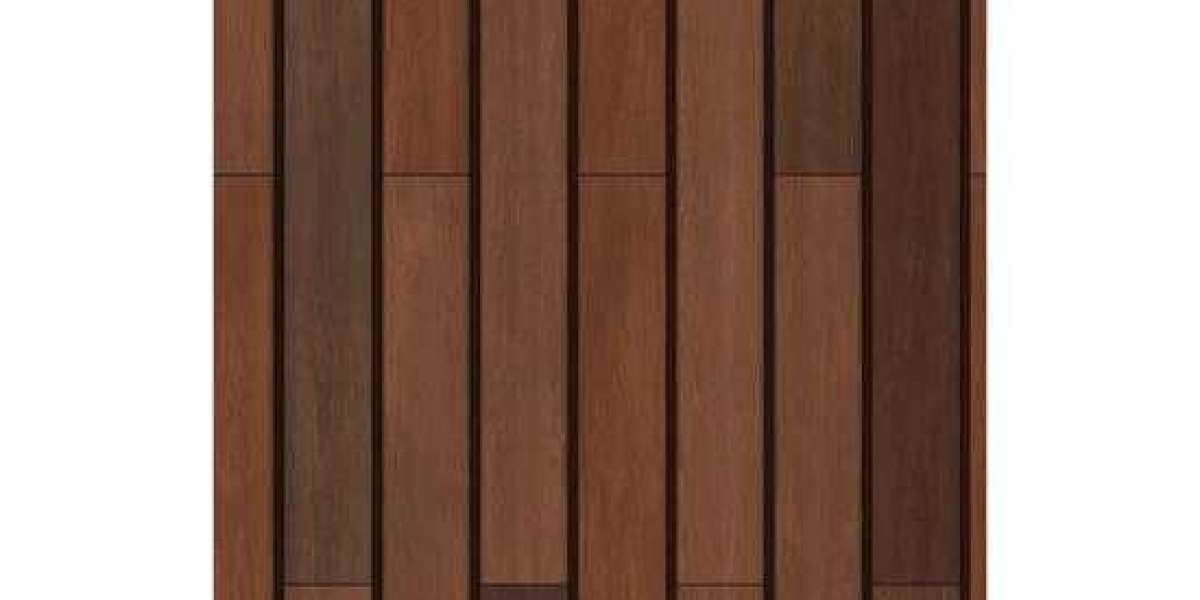In the world of modern construction and architecture, finding the perfect balance between aesthetics, durability, and sustainability is essential. One material that has been gaining popularity in recent years for achieving this balance is WPC Exterior Wall Panel. WPC, or Wood Plastic Composite, is a versatile building material made from a combination of wood fibers and thermoplastic materials. WPC exterior wall panels offer a wide range of benefits, from weather resistance to eco-friendliness, making them an ideal choice for both residential and commercial buildings.
In this comprehensive guide, we will explore what WPC exterior wall panels are, their advantages, applications, installation process, and why they are considered a game-changer in the construction industry. We’ll also answer some frequently asked questions (FAQs) to give you a complete understanding of this innovative material.
What Are WPC Exterior Wall Panels?
WPC exterior wall panels are cladding materials made from a blend of wood fibers and recycled plastic. This combination creates a durable, low-maintenance, and aesthetically pleasing material that is used to protect and decorate the exterior walls of buildings. The wood fibers give the panels a natural, wood-like appearance, while the plastic content provides superior resistance to weather, moisture, and insects.
WPC panels are available in various sizes, designs, and colors, allowing homeowners, architects, and builders to choose the perfect style for any project. They can mimic the appearance of traditional wood, stone, or other natural materials, making them an attractive and eco-friendly alternative to conventional cladding options.
Advantages of WPC Exterior Wall Panels
WPC exterior wall panels offer a wide range of advantages over traditional cladding materials like wood, vinyl, or stone. Here are some of the key benefits:
1. Durability
One of the most significant advantages of WPC exterior wall panels is their exceptional durability. The combination of wood and plastic creates a strong, long-lasting material that can withstand harsh environmental conditions. Unlike natural wood, which can rot, warp, or be damaged by termites, WPC panels are resistant to moisture, insects, and UV rays, ensuring they maintain their appearance and structural integrity over time.
2. Low Maintenance
WPC exterior wall panels require minimal maintenance compared to other cladding materials. Traditional wood panels need regular painting, staining, and sealing to protect them from the elements. In contrast, WPC panels only need occasional cleaning with water and mild detergent to keep them looking new. This low-maintenance feature makes them an attractive option for busy homeowners and commercial property managers.
3. Eco-Friendly
Sustainability is a growing concern in the construction industry, and WPC exterior wall panels are an excellent eco-friendly solution. WPC is made from recycled wood fibers and plastics, reducing the need for virgin wood and minimizing waste. Additionally, WPC panels are 100% recyclable, making them an environmentally responsible choice for green building projects.
4. Aesthetic Appeal
WPC panels are available in a wide range of colors, textures, and finishes, allowing for design flexibility. They can mimic the appearance of natural wood, stone, or other materials, giving buildings a stylish and modern look without the drawbacks of traditional materials. Whether you're aiming for a contemporary, rustic, or classic aesthetic, WPC exterior wall panels can complement any architectural style.
5. Weather Resistance
One of the most critical factors in choosing exterior wall cladding is its ability to withstand various weather conditions. WPC exterior wall panels are highly resistant to water, UV radiation, and temperature fluctuations, making them suitable for use in both hot and cold climates. They do not crack, warp, or fade, even after years of exposure to the elements.
6. Cost-Effective
While the initial WPC Sheet Price wall panels may be higher than some traditional materials, their long-term cost-effectiveness cannot be overlooked. The durability and low maintenance requirements of WPC panels reduce the need for repairs, replacements, and upkeep over time, making them a wise investment for property owners.
7. Easy Installation
WPC exterior wall panels are designed for ease of installation, often featuring interlocking systems that allow for quick and seamless attachment to the building structure. This reduces installation time and labor costs, making WPC panels an efficient choice for both new construction and renovation projects.
Applications of WPC Exterior Wall Panels
WPC exterior wall panels can be used in a variety of applications, from residential homes to commercial and industrial buildings. Here are some common uses:
1. Residential Homes
WPC panels are an excellent choice for residential homes, providing a beautiful, durable, and low-maintenance exterior cladding solution. Homeowners can choose from a range of colors and textures to match the style of their home, whether they are looking to create a modern or traditional appearance.
2. Commercial Buildings
In commercial construction, WPC exterior wall panels offer a professional, polished look while providing the durability needed to withstand high traffic and harsh weather conditions. They are often used in office buildings, shopping malls, hotels, and other commercial properties.
3. Public Buildings and Institutions
WPC panels are also suitable for public buildings, schools, hospitals, and other institutional structures. Their weather resistance and low maintenance requirements make them ideal for long-term use in public spaces.
4. Industrial and Warehousing Facilities
In industrial settings, WPC panels can be used to protect buildings from harsh environmental conditions, such as heavy rain, high winds, and UV exposure. Their durability and strength make them a practical choice for factories, warehouses, and storage facilities.
Installation Process of WPC Exterior Wall Panels
Installing WPC exterior wall panels is a relatively straightforward process, especially compared to traditional cladding materials like stone or wood. Here’s a step-by-step guide to the typical installation process:
Prepare the Surface: Before installing WPC panels, ensure that the exterior wall surface is clean, level, and free of debris. Repair any cracks or uneven areas to create a smooth base for installation.
Install the Support Structure: A support framework, usually made of wood or metal, is attached to the wall to provide a stable base for the panels. This framework should be evenly spaced to ensure proper alignment of the panels.
Attach the Panels: WPC exterior wall panels typically come with interlocking systems or concealed fasteners that allow for easy attachment to the support structure. Start from the bottom of the wall and work your way up, ensuring that each panel is level and securely fastened.
Finish the Edges: Once all the panels are installed, use trim pieces to cover the edges and corners of the wall for a clean, finished look.
Inspect and Clean: After installation, inspect the panels for any gaps or loose areas and make any necessary adjustments. Finally, clean the panels with water to remove any dust or debris from the installation process.
Conclusion
WPC exterior wall panels represent a significant advancement in the construction industry, combining the natural beauty of wood with the durability and low maintenance of plastic. Their eco-friendly nature, resistance to harsh weather conditions, and versatile design options make them a top choice for homeowners, architects, and builders alike.
Whether you're constructing a new building or renovating an existing one, WPC Sheet Design offer a stylish and sustainable solution that enhances the look and functionality of any structure. By choosing WPC panels, you’re not only investing in the longevity and appearance of your building but also contributing to a more sustainable future for the construction industry.
FAQs
1. Are WPC exterior wall panels waterproof?
Yes, WPC exterior wall panels are highly water-resistant due to the plastic content in the composite material. This makes them ideal for use in areas with high humidity or frequent rainfall, as they do not absorb water like traditional wood panels.
2. Can WPC panels be painted or stained?
WPC panels are available in a wide range of colors and finishes, so there is typically no need to paint or stain them. However, if you wish to change the color, some WPC panels can be painted using specialized coatings. It’s best to consult with the manufacturer before attempting to paint WPC panels.
3. How do WPC panels compare to traditional wood cladding?
WPC panels offer several advantages over traditional wood cladding, including greater durability, resistance to moisture, insects, and UV rays, and lower maintenance requirements. While natural wood may offer a more authentic appearance, WPC panels can closely mimic the look of wood without the drawbacks of rot, warping, and frequent upkeep.
4. Are WPC exterior wall panels environmentally friendly?
Yes, WPC exterior wall panels are an eco-friendly option. They are made from recycled wood fibers and plastics, reducing the demand for virgin materials. Additionally, WPC panels are recyclable, making them a sustainable choice for green building projects.









